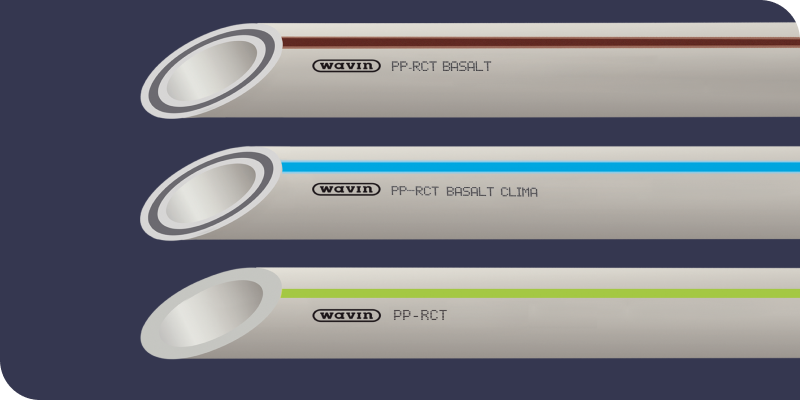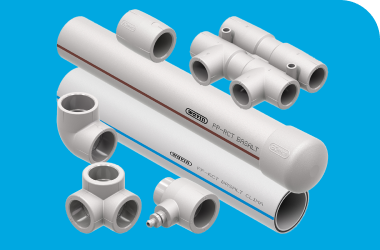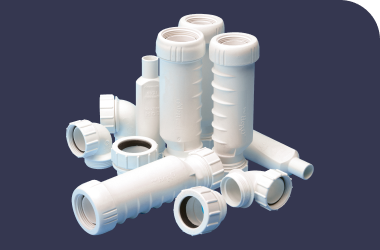
- What is PP-RCT Piping?
- What Are the Best Applications for PP-RCT Pipes?
- Advantages of PP-RCT Pipe Over Metal Piping
- What are PP-RCT Piping Materials?
- Cost Considerations for PP-RCT Pipe
- What to Know About Installing PP-RCT Pipes
- How Does PP-RCT Perform Long-Term?
- Are Low-Lead PP-RCT Fittings Available?
Metal has been king of the construction piping world for a long time; modern welded steel pipes can be traced back to the 1800s. However, the tide has turned and plumbing engineers, plumbers and pipefitters look to plastic for a variety of piping applications.
“A low carbon footprint, lightweight and fuel-efficient shipping, safe inert raw materials, long service life and recyclability are among the many features and benefits that make a plastic piping systems the preferential choice,” notes the Plastics Pipe Institute. Plastic pipes are affordable, easy to install, corrosion-resistant, and have a long lifespan.
PP-RCT pipes are used for hot-and-cold water applications but also provide exceptional strength and durability for high-pressure installations such as in high-rise buildings. Due to its properties, it is possible to use thinner-walled pipes than PP-R pipes for relatively high-pressure and high-temperature applications.
Heat fusion connects pipes with fittings, creating a continuous pipe that doesn’t leak. This makes PP-RCT a highly versatile material for plumbing professionals.
What is PP-RCT Piping?
PP-RCT stands for polypropylene random copolymer with modified crystallinity and temperature resistance a durable, rigid thermoplastic. Thermoplastics can be softened by heating, then processed and hardened while cooling. PP-RCT piping was first introduced to North America in the 2010s, following its initial introduction in Europe at the turn of the 21st century.
PP-RCT material can be made into single-layer or multi-layer pipes. Similar to welding — without the filler material — PP-RCT joints can be heat-fused, becoming one nearly leak-proof pipe. No flame, glue, solvents or O-rings are used for joining, making it safer on the job site than metal pipes.
One of the unique characteristics of PP-RCT is its high-pressure resistance at higher temperatures and low thermal conductivity. This makes it an ideal material for hot water applications. Actual pressure ratings depend on the selected wall type or thickness.
What Are the Best Applications for PP-RCT Pipes?
“The high heat and/or pressure performance makes PP-RCT [pipe] suitable for demanding applications, such as pressure piping (plumbing, hydronics) in commercial high-rise buildings,” notes the Plastics Pipe Institute (PPI).
PP-RCT materials can withstand pressures up to 120 psi at temperatures up to 180° F (82° C). This makes the piping system suitable for various compressed-air applications.
Wavin PP-RCT offers a 37% higher flow rate compared to the previous generation of piping, allowing for the use of smaller pipes and, thus, significantly saving not only costs but also the environment.
Common applications for PP-RCT pipes include:
- Domestic hot and cold potable water for residential and commercial plumbing systems;
- Chilled water and condensed water for cooling towers, data centers and supercomputers;
- Reclaimed water collection and distribution;
- Hydronic heating and cooling systems;
- Industrial and process piping for applications such as chemical processes;
- Fire protection systems;
- Rainwater harvesting systems;
- Irrigation systems; and
- Geothermal systems (distribution manifolds).
- HVAC/chiller lines, traditionally a metal application.
As Engineered Systems magazine notes: “PP pipe [and its variant PP-RCT are] hydrophobic and chemically inert. This makes [them] ideal for use in chiller systems. PP material resists any form of change to the material wall, such as scaling or corrosion, which guarantees a consistent flow rate throughout its long life. In addition, chillers operate at temperatures well within the range suitable for PP pipe.”
Advantages of PP-RCT Pipe Over Metal Piping
PP-RCT pipe is resistant to corrosion and tuberculation deposits, which can be a problem with metal pipe, especially in humid or corrosive environments. It’s a natural insulator with low thermal conductivity.
It is lightweight and easy to fabricate off-site, transport, and handle on the job. In addition, lighter weight means less strains and other back injuries for plumbers and pipefitters.

“Installation personnel are crucial to the proper functioning of the system, and many have come to genuinely appreciate working with polypropylene pipe,” Engineered Systems notes. “’You’re not moving stuff as heavy so the guys can be more productive all day long,’ said Ryan Pepper, piping project manager at T.H. Martin Inc., after the company installed PP pipe as part of a high-rise office-to-apartment conversion in Cleveland.”
Installation is also quicker; a plumber quoted in the Engineered Systems article says that what once took him 90 minutes with metal pipes took him five minutes with a plastic PP/PP-RCT system.
PP-RCT’s heat-fused joints create one continuous, leak-proof pipe. No flame, glue, or solvents are used for joining, making job sites safer — no possibility of an accidental fire. Heat fusion is a strong and highly reliable joining method — and heat-fused pipe can be used almost immediately. In addition, the process does not introduce foreign particles into the system, as can happen when cutting or welding metal pipes.
As price is a consideration in all construction projects, it’s good to note here that PP-RCT and its variants are much more price-stable than metal. Metal pipe prices are more volatile, especially when tariffs are involved.
PP-RCT has no scrap value, such as copper or stainless-steel piping, reducing the threat of job site material thefts.
What are PP-RCT Piping Materials?
Most polypropylene pipe producers reinforce the pipe with chopped glass fiber in the middle third of the pipe wall.
Wavin’s PP-RCT three-layer pipe has a middle layer containing basalt fibers derived from a volcanic material that limits linear thermal expansion changes due to varying temperatures. This ensures a better-performing, lightweight pipe with high corrosion resistance.
Basalt fibers are more environmentally friendly than metal pipe and glass fiber layer polymer alternatives. As a naturally occurring material, it is inherently more recyclable than other reinforcing fibers.
In addition, basalt fiber is electrically nonconductive and features low water absorption, important in construction and pipe applications.
Cost Considerations for PP-RCT Pipe
Initial material and labor costs are lower than metal piping systems. PP-RCT pipe is lightweight and easy to install, saving time and money.
When taking into consideration the overall cost of installation, material, and labor versus comparable steel, saving comes not only in the material itself, but also in terms of no fire watches needed, burn permits, safety welding curtains, and no extra people to handle the extra weight as the product weight is about one-third of comparable steel.
PP-RCT enjoys consistent market pricing vs. metallic systems (commodity pricing). In addition, the cost of maintaining the piping system by the builder owners is much lower. Also, pipe descaling is not needed or reduced drastically because of the superior corrosion and scaling properties of PP-RCT.
What to Know About Installing PP-RCT Pipes
With heat-fused joints, no flame, glue, or solvents are required for joining, so there is no need for special pipe preparation. Heat fusion makes prefabrication straightforward, making it easy to bring prefabbed units to the job site.
“Unlike metal pipe, [PP-RCT] pipe’s lightweight and versatile orientations that are available through the fusion process make it easy to fabricate custom spools either on the job site or remotely,” Engineered Systems explains. ”Some manufacturers of PP systems offer design and fabrication services and have BIM files available for their products.”
PP-RCT pipe can be sized for the flow rate of the hot or cold water system, or for head loss, depending on the application.
Refer to Wavin’s PP-RCT technical information pricing and installation instructions.
How Does PP-RCT Perform Long-Term?
PP-RCT pipes have a long service life, typically 50 years or more. As previously noted, it creates a practically leak-proof connection when the pipes and fittings become one continuous piece through the heat-fusion process.
Wavin PP-RCT’s basalt layer offers high resistance to corrosion, low water absorption, and electric nonconductivity — it is not subject to pitting and other deterioration of other piping materials.
Are Low-Lead PP-RCT Fittings Available?
Wavin system fittings have the highest specification quality of C69300 brass with the lowest lead content available, far exceeding U.S. lead-free requirements.
In conclusion, PP-RCT piping emerges as a superior choice in modern plumbing and high-pressure applications due to its numerous advantages over traditional metal and other plastic piping systems. The environmental benefits of Wavin PP-RCT, including the middle layer of basalt fibers, make it the future-oriented choice for engineers and plumbers seeking reliable, efficient, and eco-friendly piping solutions.
Media Contacts
Kacy Karlen
Chief Communications Officer, Orbia
kacy.karlen@orbia.com
+1 (865) 410-3001
Nora DePalma
Dialogue for Wavin NA
nora@dialogue.marketing
+1 (678) 642-5075





.png?width=380&height=250&name=wavin-us-pprct%201%20(1).png)
